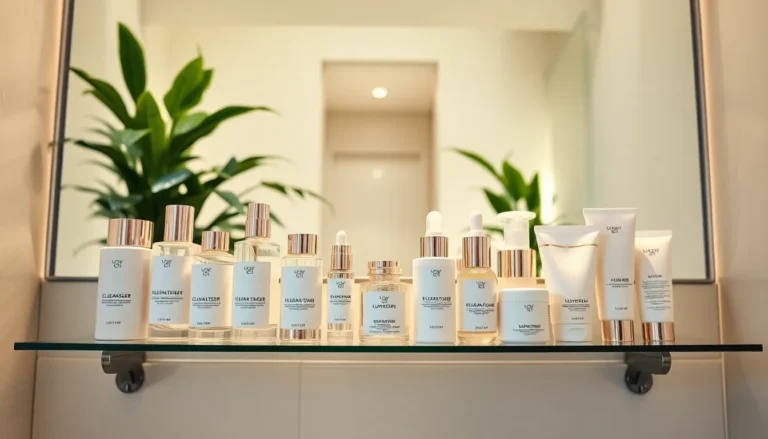Table of Contents
ToggleIn a world where stress and pollution seem to have their own skincare routine, it’s time to take matters into your own hands. A solid skincare routine isn’t just a luxury; it’s an essential armor against the daily battles your skin faces. Whether you’re a seasoned skincare guru or just starting out, the right routine can transform your complexion from drab to fab faster than you can say “moisturizer.”
What Are Skincare Routines?
Skincare routines consist of a series of steps designed to maintain and enhance skin health. These routines often begin with cleansing the skin to remove dirt, oil, and impurities. Following cleansing, toners frequently play a role in balancing skin pH and preparing the skin for other products.
Moisturization is crucial in a skincare routine, providing hydration and preventing dryness. Some people incorporate serums into their regimen, delivering concentrated ingredients targeting specific concerns, like acne or aging. Exfoliation also finds its place within these routines, helping to slough off dead skin cells and promote cell turnover.
Nighttime routines may differ from morning practices, emphasizing recovery during sleep. Individuals often opt for heavier creams at night, ensuring skin benefits overnight. Additional steps may include applying eye creams to address under-eye issues.
Tailoring a skincare routine to skin type enhances its effectiveness. Oily skin requires lightweight products, while dry skin benefits from richer formulations. Customization accounts for environmental factors, such as humidity and pollution levels, allowing skincare routines to adapt to changing conditions.
Effective skincare routines operate as a multi-step approach ensuring the skin maintains its vitality. Regular adherence to these routines may promote healthier skin, making it essential for overall wellbeing.
Key Steps in a Skincare Routine
A structured skincare routine enhances overall skin health. Each step serves a distinct purpose to achieve optimal results.
Cleansing
Cleansing removes dirt, oil, and impurities from the skin’s surface. This crucial first step prepares the skin for subsequent treatments. Gentle cleansers work well for sensitive skin, while foaming options suit oily skin types. Morning and evening cleansing helps maintain clear skin and prevents buildup. It’s essential to select a cleanser that aligns with skin concerns for better results.
Exfoliating
Exfoliating promotes cell turnover and removes dead skin cells. Regular exfoliation reveals a brighter complexion. Chemical exfoliants, like AHAs and BHAs, target specific issues effectively. Physical exfoliants, like scrubs, provide immediate results but should be used sparingly. Twice a week strikes a balance for most skin types, enhancing the effectiveness of other products applied afterward.
Toning
Toning balances the skin’s pH and preps it for product absorption. This step can also address specific skin concerns, such as excess oil or dryness. Toners with hydrating ingredients offer a soothing effect, while astringent types reduce oiliness. Application occurs after cleansing, making it a vital link in the routine. Selecting the right toner enhances overall skin clarity and texture.
Moisturizing
Moisturizing hydrates and protects the skin barrier. Everyone should incorporate this step to maintain moisture levels. Lightweight lotions benefit oily skin, while thicker creams serve dry skin effectively. Applying moisturizer morning and night locks in hydration and supports skin elasticity. Targeted formulations can address specific concerns, from aging to acne.
Sunscreen
Sunscreen protects the skin from harmful UV rays. Daily application is essential, even on cloudy days. Broad-spectrum options guard against both UVA and UVB rays. Choosing a sunscreen with an SPF of at least 30 provides adequate protection. Incorporating this step into the morning routine safeguards against premature aging and skin damage.
Types of Skincare Routines
Skincare routines vary based on time of day and seasonal changes, addressing specific skin needs effectively.
Morning Skincare Routine
A morning skincare routine involves steps that prepare the skin for daily activities. Begin with a gentle cleanser to remove overnight impurities. Follow this by applying a toner that balances pH levels. Next, a lightweight moisturizer hydrates the skin without feeling heavy. Sunscreen is essential, offering protection against UV rays and environmental factors. Individuals with specific concerns might add a serum targeting issues like dark spots or fine lines. Incorporating these steps starts the day with fresh, healthy skin.
Evening Skincare Routine
An evening skincare routine targets repair and rejuvenation. Start by using a makeup remover to ensure all traces of products vanish. Follow up with a deeper cleanse that effectively removes dirt and oil accumulated throughout the day. Exfoliation, whether chemical or physical, promotes cellular turnover, enhancing skin texture. After cleansing, applying a nourishing night cream moisturizes and aids skin recovery. Eye creams can also address under-eye issues specifically. Emphasis on these steps leads to radiant skin by morning.
Seasonal Skincare Routine
Seasonal skincare routines adapt to environmental changes throughout the year. In winter, richer moisturizers combat dryness resulting from cold air and indoor heating. When summer arrives, lightweight formulas along with gel-based moisturizers maintain hydration without excess oil. Transitioning to suitable sunscreens becomes critical during the hot months. Individuals often modify exfoliation frequency depending on humidity levels as well. By tailoring routines according to the season, skin remains balanced and healthy year-round.
Common Skincare Mistakes to Avoid
Avoiding common skincare mistakes can enhance the effectiveness of any routine. Skipping sunscreen each morning remains a frequent error that leads to long-term skin damage. Many individuals forget to apply sunscreen daily, even on cloudy days, exposing their skin to harmful UV rays. Using products without checking expiration dates also poses risks; expired products can irritate the skin and lead to breakouts.
Ignoring skin type when selecting products constitutes another critical oversight. Oily skin benefits from lightweight, non-comedogenic formulations, while dry skin thrives with richer moisturizers. People often apply harsh exfoliants too frequently, disrupting the skin barrier and resulting in irritation. Instead, gentle exfoliation, one to two times per week, promotes healthy cell turnover without causing harm.
Neglecting to cleanse the skin properly before bed can lead to clogged pores and breakouts. Evening cleansing should include makeup removal followed by a thorough wash to eliminate impurities. Applying products in the wrong order can also diminish their effectiveness. Typically, lighter products like serums go before heavier moisturizers for optimal absorption.
Rushing through the skincare routine, particularly during the cleansing and application phases, undermines potential benefits. Taking the time to massage products into the skin enhances absorption and boosts circulation. Finally, individuals often expect overnight miracles from their skincare; significant changes typically require consistency over time for visible results.
Establishing a skincare routine is essential for maintaining healthy skin and addressing individual needs. By incorporating key steps like cleansing, exfoliating, toning, and moisturizing, individuals can create a regimen that suits their skin type and lifestyle.
Customization is crucial as it allows for adjustments based on environmental factors and personal preferences. Avoiding common mistakes ensures the routine remains effective and beneficial.
With patience and consistency, anyone can achieve noticeable improvements in their skin’s appearance and health. Embracing a dedicated skincare routine not only enhances one’s complexion but also contributes to overall wellbeing.




